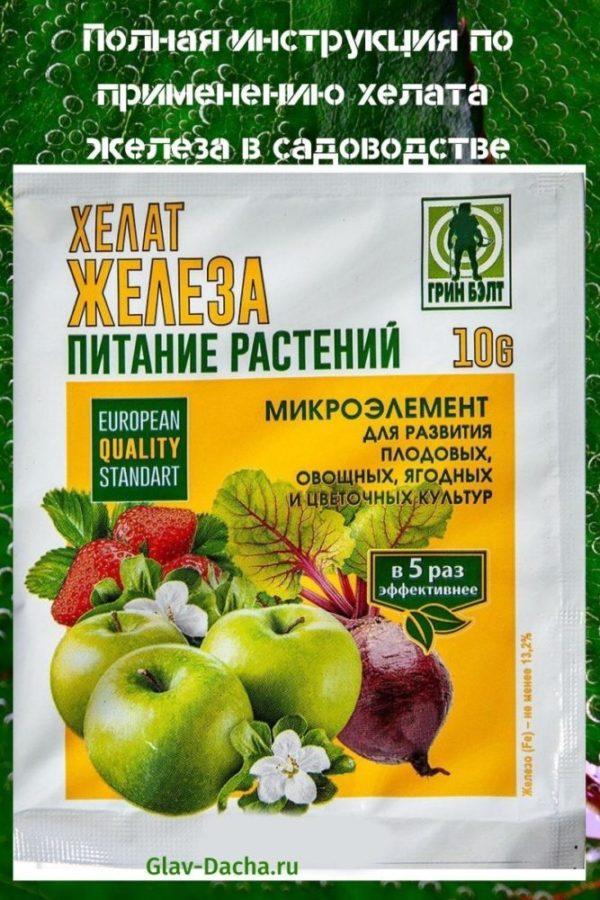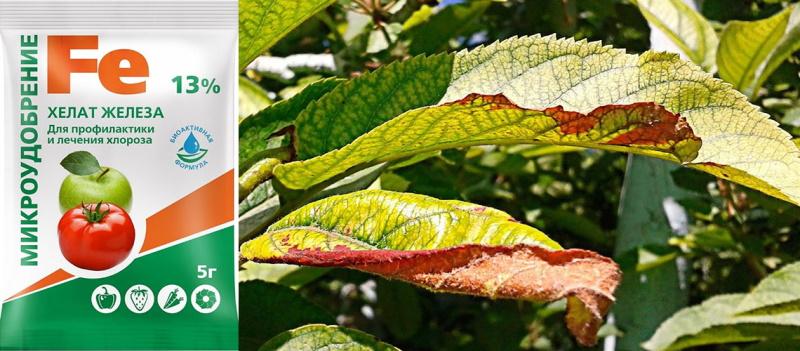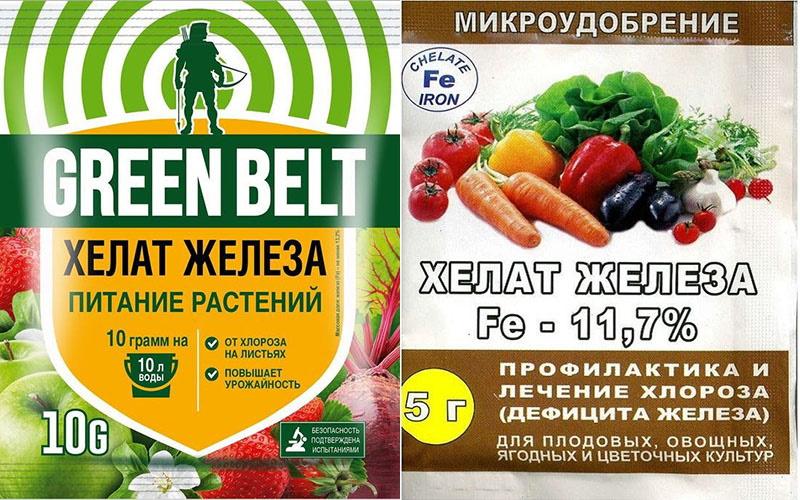Complete instructions for the use of iron chelate in gardening
 Chlorosis in horticultural crops leads to premature yellowing of foliage and its fall, and in the future, complete death of tissues. Detailed instructions for the use of iron chelate will help prevent, as well as cure plants from a lack of a valuable biologically significant trace element. It describes in detail the consumption rates of the agrochemical and recommendations for the preparation of the working fluid.
Chlorosis in horticultural crops leads to premature yellowing of foliage and its fall, and in the future, complete death of tissues. Detailed instructions for the use of iron chelate will help prevent, as well as cure plants from a lack of a valuable biologically significant trace element. It describes in detail the consumption rates of the agrochemical and recommendations for the preparation of the working fluid.
Description of the drug
 Iron chelate is a micronutrient fertilizer in a biologically active form. The tool is a combination of organic acids and metal ions. It contains 11-13.2% Fe (30 g / l).
Iron chelate is a micronutrient fertilizer in a biologically active form. The tool is a combination of organic acids and metal ions. It contains 11-13.2% Fe (30 g / l).
Such a mass fraction of nutrients helps to accelerate vital processes and increase crop yields:
- fruit;
- berry;
- vegetable;
- field;
- decorative;
- grapes.
 The acidity of the substance (odorless orange / burgundy powder) is 6-8 pH. The iron chelate formula is very complex. The structure of the molecule has a pincer-like structure in which organic acids (agents) are attached to metal ions using a special form of bonds, a kind of pincers.
The acidity of the substance (odorless orange / burgundy powder) is 6-8 pH. The iron chelate formula is very complex. The structure of the molecule has a pincer-like structure in which organic acids (agents) are attached to metal ions using a special form of bonds, a kind of pincers.
Thanks to this, the metal freely enters the tissues of the plant, without being destroyed under the influence of:
- water;
- oxygen;
- soil substrate.
Chelating compounds are also produced in humus when humic acids react with soil components. This explains the biological activity of the agrochemical.
 Having reached the “destination”, the chelated elements release iron from their “claws”. Once in living cells, trace elements are converted into biologically available substances. Moreover, the agents themselves break down into chemical compounds that are easily absorbed by vegetable plants. Unlike conventional mineral complexes, which are absorbed by crops only by 30-40%, microfertilizer based on chelates is absorbed by almost 90%. In addition, their "family ties" with amino acids, nucleic acids and proteins make the drug completely harmless to young immature crops. Thus, the plant iron chelate is used without any limitation.
Having reached the “destination”, the chelated elements release iron from their “claws”. Once in living cells, trace elements are converted into biologically available substances. Moreover, the agents themselves break down into chemical compounds that are easily absorbed by vegetable plants. Unlike conventional mineral complexes, which are absorbed by crops only by 30-40%, microfertilizer based on chelates is absorbed by almost 90%. In addition, their "family ties" with amino acids, nucleic acids and proteins make the drug completely harmless to young immature crops. Thus, the plant iron chelate is used without any limitation.
Fertilizer benefits
 A separate point is to highlight the positive aspects of using the amino acid complex. As already noted, a lack of Fe leads to a decrease in yield. With its deficiency, a disease such as chlorosis develops.
A separate point is to highlight the positive aspects of using the amino acid complex. As already noted, a lack of Fe leads to a decrease in yield. With its deficiency, a disease such as chlorosis develops.
In addition to yellowing and falling foliage, it is also observed:
- dying off of new shoots;
- lagging (slowing down) in growth;
- crushing inflorescences;
- deterioration in the quality of fruits / vegetables.
 Iron plays a leading role in the full development of plants. Due to the ability of the metal atom to quickly change / restore the oxidation state, the trace element takes an active part in the transport of electrons and nutrients during biochemical processes. In addition, Fe molecules are involved in chlorophyll biosynthesis. Without a sufficient amount of this natural material, the respiratory function of the culture will be disrupted.
Iron plays a leading role in the full development of plants. Due to the ability of the metal atom to quickly change / restore the oxidation state, the trace element takes an active part in the transport of electrons and nutrients during biochemical processes. In addition, Fe molecules are involved in chlorophyll biosynthesis. Without a sufficient amount of this natural material, the respiratory function of the culture will be disrupted.
With an optimal Fe mass in cells, metabolism is normalized. Also, metal compounds stimulate the balance of the absorption of nutrients.
Instructions for the use of iron chelate in detail
 The working solution is prepared according to the standard scheme. The contents of the sachet (5 g of the preparation) are dissolved in a small amount of water.Then the resulting suspension is brought to a volume of 10 liters, stirring constantly. In the case of severe Fe deficiency, the proposed dosage is doubled to obtain a more concentrated composition.
The working solution is prepared according to the standard scheme. The contents of the sachet (5 g of the preparation) are dissolved in a small amount of water.Then the resulting suspension is brought to a volume of 10 liters, stirring constantly. In the case of severe Fe deficiency, the proposed dosage is doubled to obtain a more concentrated composition.
In this case, the consumption of the solution is:
- 2 l / m² for irrigation;
- 1 l / m² when spraying.
 To prepare the working fluid of the chelate at home, do not use metal utensils. At the same time, some manufacturers offer different dosage rates for the drug.
To prepare the working fluid of the chelate at home, do not use metal utensils. At the same time, some manufacturers offer different dosage rates for the drug.
For the processing of vegetable, flower-ornamental and fruit-berry crops, a suspension is prepared, depending on the intended purpose:
- Foliar top dressing. The dosage of micronutrient fertilizer is 2-5 g / l. For every 10 m², up to 1-1.5 liters of prepared liquid are consumed. The procedure is performed during the growing season. The frequency of spraying is no more than 2 per season. The first spraying is usually carried out when 3-5 full leaves appear, and the second after 10-15 days.
- Root feeding (with severe iron deficiency). The dosage of the drug is calculated depending on the degree of progression chlorosis... Usually the rate of an agrochemical is 5-10 g / l. Working fluid flow rate varies from 1 to 5 liters per 1 m². The number of irrigations for the entire growing season is 1-2 with an interval of 10 or 15 days.

In case of severe chlorosis, a concentrated solution of complex micronutrient fertilizer is applied at the root or in a hole made near the culture at a depth of 20-25 cm.For an adult tree, the dosage of the drug is 10-20 liters, for shrubs (currants, raspberries, gooseberries) - 1-2 l / bush, for vegetables and berries - 4-5 l / weave.
 Some instructions for the use of iron chelate indicate a completely different way of preparing the working fluid. Manufacturers offer to gradually introduce the powder into water at room temperature, while stirring vigorously, or vice versa, pour liquid into the powdery mass. After complete dissolution of the fertilizer, the resulting suspension is used as a prophylactic or therapeutic agent. For better assimilation of the drug, spraying is carried out both on the upper and lower parts of the foliage.
Some instructions for the use of iron chelate indicate a completely different way of preparing the working fluid. Manufacturers offer to gradually introduce the powder into water at room temperature, while stirring vigorously, or vice versa, pour liquid into the powdery mass. After complete dissolution of the fertilizer, the resulting suspension is used as a prophylactic or therapeutic agent. For better assimilation of the drug, spraying is carried out both on the upper and lower parts of the foliage. 
Other methods of use
 Some creative farmers use iron chelate for seed dressing. Before sowing, the planting material is soaked in a weak solution for 30 minutes. This improves the germination of seeds, and also increases the resistance of plants to various kinds of diseases. At the same time, micronutrient fertilization is effective in growing seedlings. After transplanting, the seedlings are watered with a working liquid with a minimum dosage.
Some creative farmers use iron chelate for seed dressing. Before sowing, the planting material is soaked in a weak solution for 30 minutes. This improves the germination of seeds, and also increases the resistance of plants to various kinds of diseases. At the same time, micronutrient fertilization is effective in growing seedlings. After transplanting, the seedlings are watered with a working liquid with a minimum dosage.
Thanks to such feeding of the culture:
- take root better and faster;
- adapt to new conditions;
- develop immunity to infectious diseases.
 Among other things, the nutrient promotes the active formation of ovaries, as well as the preservation of inflorescences. Therefore, a solution of iron chelate is sprayed with the planting after the formation of buds, but before flowering.
Among other things, the nutrient promotes the active formation of ovaries, as well as the preservation of inflorescences. Therefore, a solution of iron chelate is sprayed with the planting after the formation of buds, but before flowering.
Especially in iron need cultures that do not grow in favorable or unusual conditions for them. Therefore, it will not be superfluous to spray or water such plants with a nutrient solution.
Director yourself or how to make iron chelate with your own hands
 You can get a valuable metal-based fertilizer at home. To do this, take 1 tbsp. l of citric acid or 10 g of ascorbic acid (in pure form, without glucose), as well as 1 tsp. copper sulfate. Bring 3 liters of water to a boil. As soon as the liquid has cooled, add all the ingredients in turn. The composition is thoroughly mixed. Copper sulfate is often diluted separately in 0.5 liters of water at room temperature, and only then mixed with other components. As a result of this home experiment, a light orange solution is obtained.
You can get a valuable metal-based fertilizer at home. To do this, take 1 tbsp. l of citric acid or 10 g of ascorbic acid (in pure form, without glucose), as well as 1 tsp. copper sulfate. Bring 3 liters of water to a boil. As soon as the liquid has cooled, add all the ingredients in turn. The composition is thoroughly mixed. Copper sulfate is often diluted separately in 0.5 liters of water at room temperature, and only then mixed with other components. As a result of this home experiment, a light orange solution is obtained.
Do-it-yourself iron chelate is not inferior to industrial analogues. Nevertheless, during storage of the working fluid, the metal precipitates.Therefore, spraying with a settled suspension will not bring the desired results.
Precautions
 Despite the biological activity of the drug and its beneficial properties, it is important to be careful when using it. When processing the fit, it is recommended to wear rubber gloves. After the end of spraying / watering, it is advised to wash your face and hands with soap. If the solution gets into the eyes, they are washed with a large amount of liquid, and inside, they induce vomiting. Also, the storage conditions of the drug, prescribed in the instructions for the use of iron chelate, are observed.
Despite the biological activity of the drug and its beneficial properties, it is important to be careful when using it. When processing the fit, it is recommended to wear rubber gloves. After the end of spraying / watering, it is advised to wash your face and hands with soap. If the solution gets into the eyes, they are washed with a large amount of liquid, and inside, they induce vomiting. Also, the storage conditions of the drug, prescribed in the instructions for the use of iron chelate, are observed.
Microfertilizer is stored:
- in a dry, dark and closed room;
- at a temperature of 0-25˚С;
- out of the reach of children and animals;
- away from food and drugs;
- in a hermetically sealed package.
The agrochemical is classified as hazard class 3. It is also a fire and explosive agent. Therefore, during the preparation of the solution, the containers are kept away from heating objects and open flames. In addition, the substance is protected from dampness, otherwise the powdery mass crystallizes.